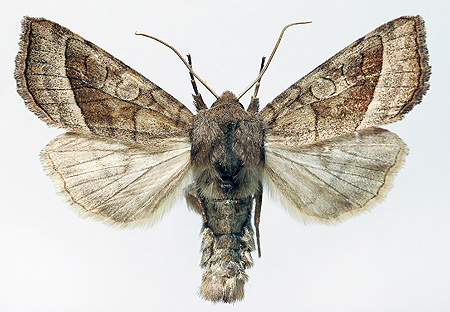Pests
Hydraecia micacea (Esper) - Potato Stem Borer
Systematic position.
Class Insecta, order Lepidoptera, superfamily Noctuoidea, family Noctuidae, subfamily Hadeninae, genus Hydraecia. Several sister species may occur in Primorskii Territory.Synonyms.
Gortyna micacea Esp.Biological group.
Pest of vegetable and industrial crops.Morphology and biology.
Forewings of the moth grayish-yellow or dark brown-gray, with reddish tint (wingspan 28-40 mm). Transversal lines brown. A part of the wing between the lines is darker than the rest, especially behind round and reniform spots having background wing color. Hind wings grayish-yellow or pinkish-yellow, with a dark stripe in distal third of wing. Females usually larger than males. Egg semispherical, yellowish-white, later pinkish. Diameter of eggs 0.7-0.8 mm, height 0.4 mm. Caterpillars light yellow to fleshy-red with reddish stripe along dorsum. Head red, without pattern; thoracic and anal shields and plates bearing setae, brown. Spiracles black. Caterpillars 40-45 mm long. Pupae yellow-brown, 17-25 mm in length; cremaster with 2 processes. Eggs winter, but there is data on wintering caterpillars of early instars. Females lay eggs behind leaf axils and on the lower parts of stalks of host plants in 2-3 rows, by groups of 20-60, maximum 200 eggs. Caterpillars pupate in cocoons in ground.Distribution.
Northern America (adventive); Europe, Middle East (Turkey), Mongolia, Northeast China, Japan, Central Asia, Kazakhstan, Baltic States, Byelorussia, Ukraine, Moldova. In Russia, the species is distributed in all European part (except for Polar regions), in Ural, Altai, southern and western Siberia, the Far East (Khabarovsk Territory, Kamchatka and Sakhalin Regions).Ecology.
Monovoltine species. Caterpillars hatch in mid-May. They pupate the beginning of June until August. Moths fly from the end of July until late autumn. Migration of caterpillars from one plant to another is characteristic. The species is confined to lower humid habitats. Parasites of the species are known; e.g., tachinid fly Ceromasia stabulans Meig. and 8 hymenopteran species including ichneumonids Ichneumon sarcitorius L., Campoplex stragifex Forrst., and braconids Macrocentrus infirmus Nees and M. collaris (Nees) Hal.Economic significance.
The pest occurs on 50 plant species from 20 families. It significantly harms potato, rhubarb, hop, tomato, corn, onion, garlic, strawberry, raspberry, ornamental plants (lilies, irises, etc.). Caterpillars frequently develop on reed, sedge, blue flag, couch-grass, manna, etc. In spring they eat holes in cereal leaves first then stalks; they gnaw out cavities in bulbs, tubers, and roots. Plant buds and ovaries are sometimes damaged.Control measures: Agronomical ones are destruction of weeds on fields and adjacent sites, removal of plant residues. Chemical ones are insecticide treatments in the period of caterpillar hatching.
Reference citations:
Klyuchko Z.F. 1974. Noctuidae. In: Vasil.ev V.P., ed. Pests of agricultural crops and forest plantations. V.2. Arthropods. Kiev: Urozhai, p. 361-408 (in Russian).Pospelov S.M. 1975. Noctuidae - Pests of agricultural crops in NW Russia. DSc Thesis. Leningrad - Pushkin, 43 p. (in Russian).
Pospelov S.M. 1989. Noctuidae - Pests of agricultural crops. Moscow: Agropromizdat, 112 p. (in Russian).
Sukhareva I.L. 1999. Noctuidae. In: Kuznetsov V.I., ed. Insects and mites - agricultural pests. V. 3(2). Lepidoptera. St.Petersburg: Nauka, p. 332-378 (in Russian).


